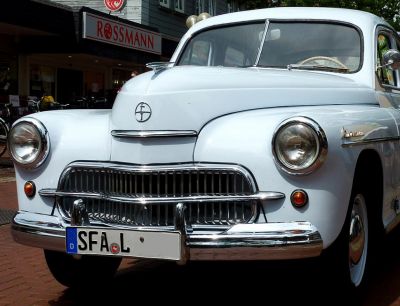 1955 GAZ M-20B Pobeda Dimensions, Size & Specs
1955 GAZ M-20B Pobeda Dimensions, Size & SpecsMeasurements of the 1955 GAZ M-20B Pobeda, engineered for optimal performance and comfort
| Dimensions | |
|---|---|
| Length: | 4665 mm183.7 in15.3 ft |
| Width: | 1695 mm66.7 in5.6 ft |
| Height: | 1640 mm64.6 in5.4 ft |
| Ground Clearance: | 200 mm7.9 in0.7 ft |
| Weight Specifications | |
| Curb Weight: | 1360 kg2998 lbs |
The GAZ M-20B Pobeda, produced between 1955 and 1958, is a notable classic Soviet-era vehicle available in both sedan and coupe body styles. Characterized by its streamlined and robust design, the M-20B Pobeda reflects mid-20th century automotive trends in the Soviet Union. Measuring 4665 mm (183.7 inches) in length, 1695 mm (66.7 inches) in width, and standing 1640 mm (64.6 inches) tall, this model offers a balanced and spacious profile for its time. The curb weight of the M-20B is approximately 1360 kg (2998 lbs), which contributes to its stable and smooth ride dynamics. The car’s ground clearance is 200 mm (7.9 inches), suitable for the varied road conditions typical of the region during its production years. The M-20B Pobeda’s dimensions and weight make it a robust and practical automobile, embodying the Soviet automotive philosophy of durability and functionality. This generation of the Pobeda model continued to build upon the legacy of its predecessors, offering consumers a solid and dependable vehicle that remains iconic in classic car culture today.
Discover the standout features that make the 1955 GAZ M-20B Pobeda a leader in its class
Have a question? Please check our knowledgebase first.
The GAZ M-20B Pobeda measures 4665 mm (183.7 inches) in length, 1695 mm (66.7 inches) in width, and 1640 mm (64.6 inches) in height. These dimensions give the car a classic mid-20th century sedan profile, combining a relatively compact footprint with an elevated roofline for comfortable interior headroom. The width allows for a spacious passenger cabin without being overly wide, suitable for the roads and infrastructure of the 1950s Soviet Union.
The curb weight of the GAZ M-20B Pobeda is approximately 1360 kg (2998 lbs). This moderate weight for a mid-1950s sedan contributed to manageable handling and decent fuel efficiency compared to heavier contemporary vehicles. The weight also means the car benefits from a solid, sturdy build typical of Soviet engineering of the period, which helped it maintain durability and reliability on rough roads despite a relatively basic suspension setup.
The GAZ M-20B Pobeda features a ground clearance of 200 mm (7.9 inches), which is quite generous for a passenger car. This elevated ride height enhanced its ability to handle unpaved and uneven road surfaces common in the Soviet Union during the 1950s, making it a versatile vehicle for both urban and rural environments. The higher clearance also contributed to better protection of the undercarriage from debris and rough terrain.
Yes, the GAZ M-20B Pobeda can fit into a standard garage. With a length of 4665 mm (183.7 inches) and width of 1695 mm (66.7 inches), it falls within the typical dimensions that most residential garages accommodate. Additionally, its height of 1640 mm (64.6 inches) is well below usual garage door heights, so parking inside a conventional single-car garage would generally not pose any spatial challenges, making it practical for everyday use and storage.
The GAZ M-20B Pobeda is essentially an evolution of the original M-20 model, produced from 1946 to 1955. While the overall length, width, and height remained largely consistent with incremental refinements, the M-20B introduced improvements such as a more refined body and better trim to enhance comfort and appeal. Dimensional changes were minor but aimed at improving interior space and the vehicle's aerodynamic silhouette, reflecting a natural progression rather than a complete redesign.
Compared to mid-1950s sedans from Western Europe and the United States, the GAZ M-20B Pobeda is relatively compact. For example, the Chevrolet Bel Air of the same era is longer (around 5099 mm or 200.7 inches) and wider (around 1895 mm or 74.6 inches). The Pobeda’s dimensions reflected the practical needs and road infrastructure of the Soviet Union while providing sufficient interior space for passengers without excessive size that might hinder maneuverability or fuel economy.
The GAZ M-20B Pobeda was designed to seat up to five passengers comfortably in a traditional sedan layout with front bench seats and a spacious rear bench. Its dimensions allowed for reasonable legroom and headroom for the period, making it suitable as a family car or official vehicle. Although detailed interior volume figures aren't widely documented, the vehicle's boxy but slightly aerodynamic shape maximized usable cabin space within its compact external dimensions.
The GAZ M-20B Pobeda was primarily offered as a four-door sedan but also had a coupe variant that featured a sportier two-door design. Dimensionally, the coupe shared similar length, width, and height measurements to the sedan but had a slightly lower roofline and altered rear styling to emphasize its sportier character. These changes did not significantly affect overall size but gave buyers options depending on their preference for passenger capacity versus style.
The 200 mm (7.9 inches) ground clearance of the GAZ M-20B Pobeda was well-suited for the varied and often rough Soviet roads of the 1950s. This higher clearance allowed the vehicle to navigate over potholes, snow, and uneven terrain effectively without risking damage to the chassis or underbody components. It made the Pobeda a practical choice for both urban centers and rural areas, providing versatility that appealed to many buyers and fleets in the USSR.
The GAZ M-20B Pobeda’s weight of approximately 1360 kg (2998 lbs) combined with its modest engine output typical of the 1950s meant fuel efficiency was average for its class at the time, balancing performance and economy reasonably well. The car's size and weight contributed to a stable and comfortable ride but limited sporty handling or acceleration. Designed for durability and steady operation rather than speed, it offered reliable transportation with manageable fuel consumption in the context of post-war Soviet automotive conditions.
Discover similar sized cars.

| Production: | 1946-1956 |
|---|---|
| Model Year: | 1946 |
| Length: | 4665 mm183.7 in |
| Width: | 1695 mm66.7 in |
| Height: | 1640 mm64.6 in |

| Model Year: | 1946 |
|---|---|
| Length: | 4665 mm183.7 in |
| Width: | 1695 mm66.7 in |
| Height: | 1640 mm64.6 in |
